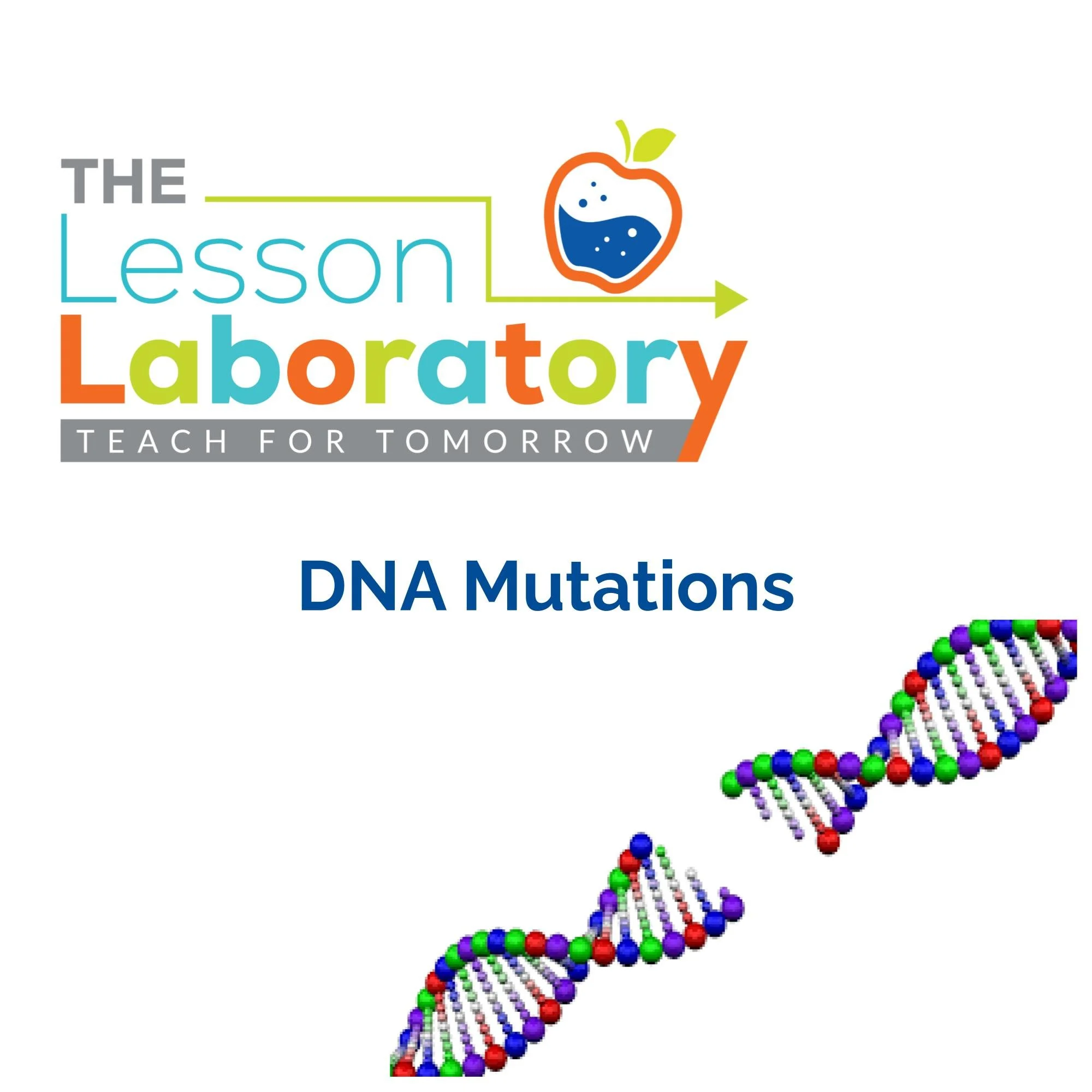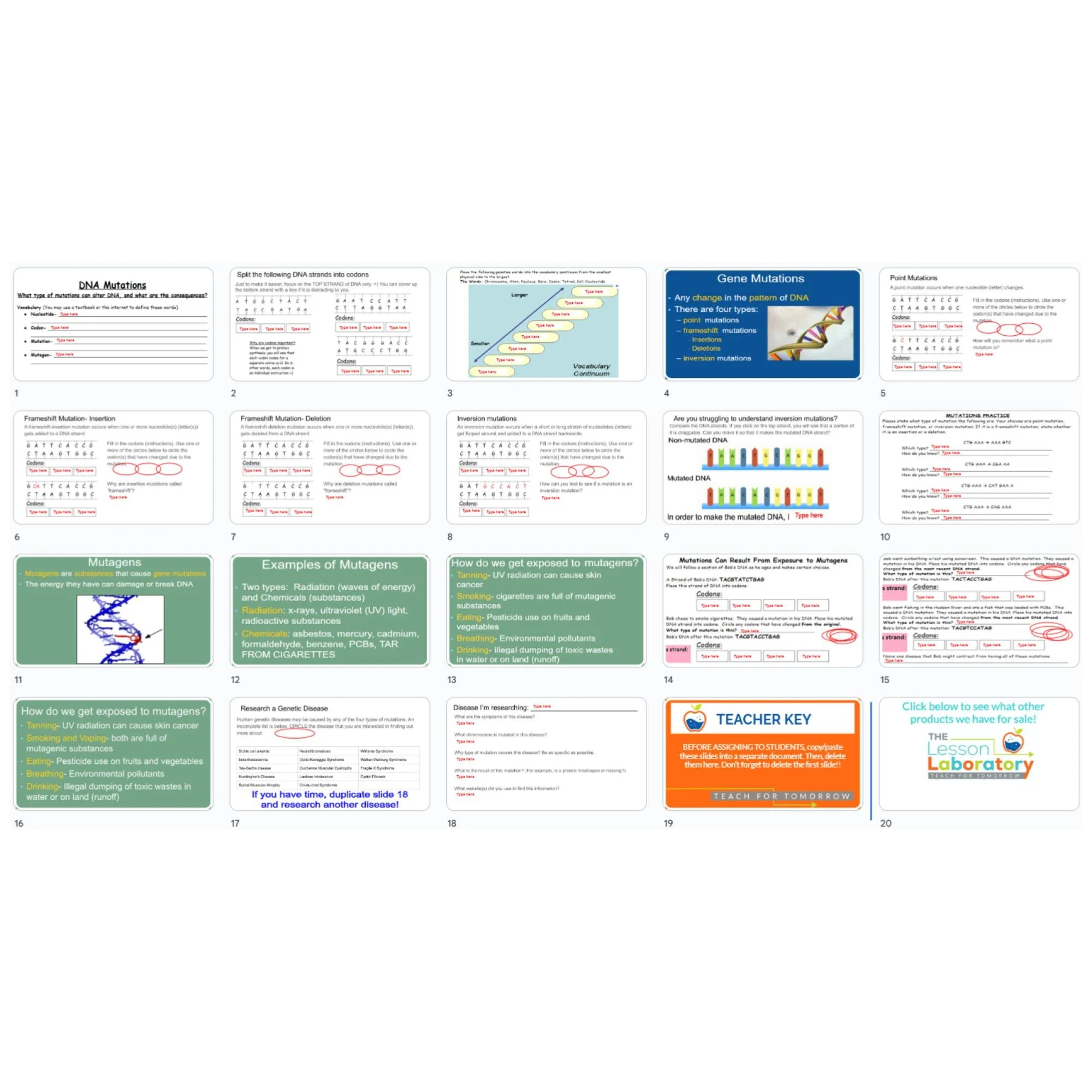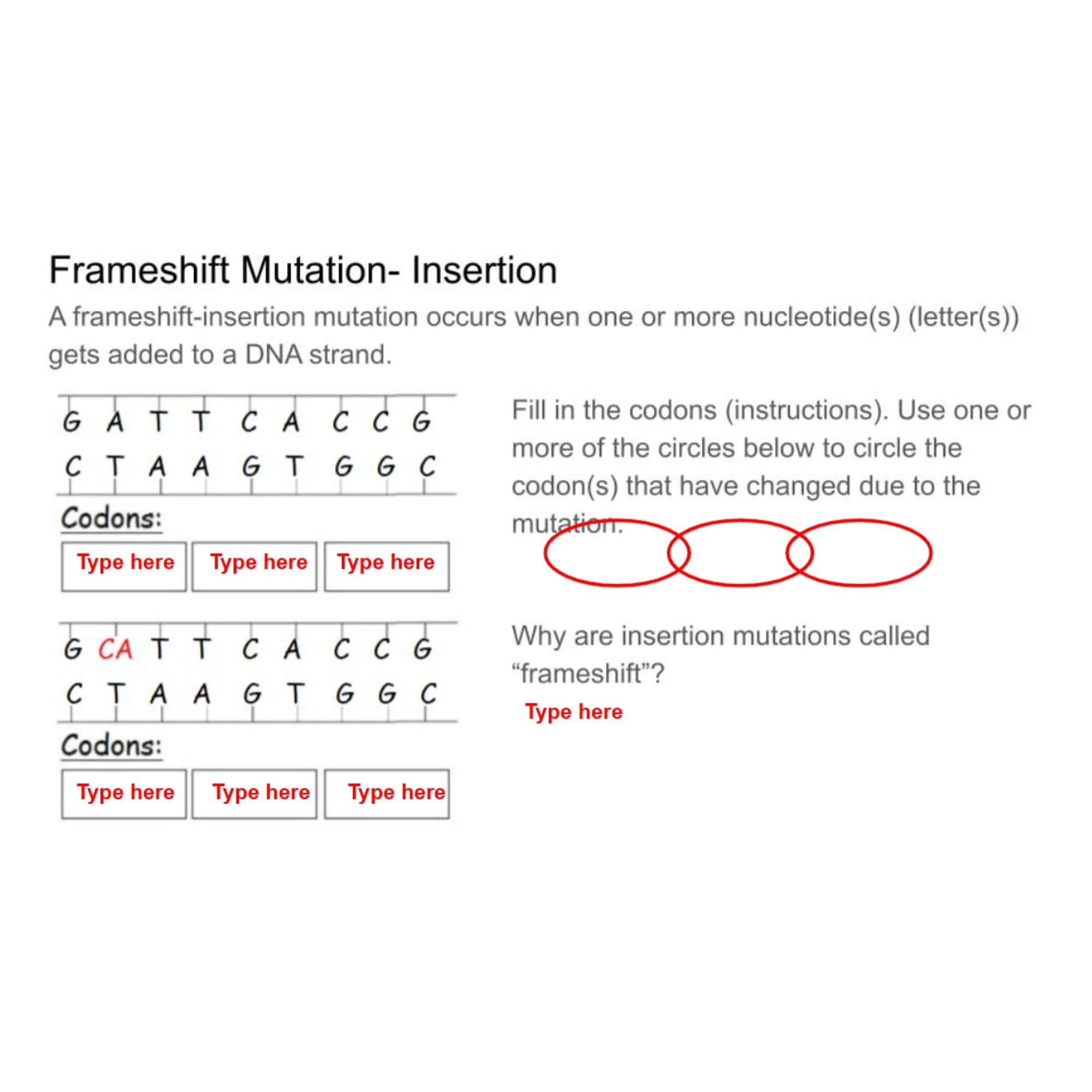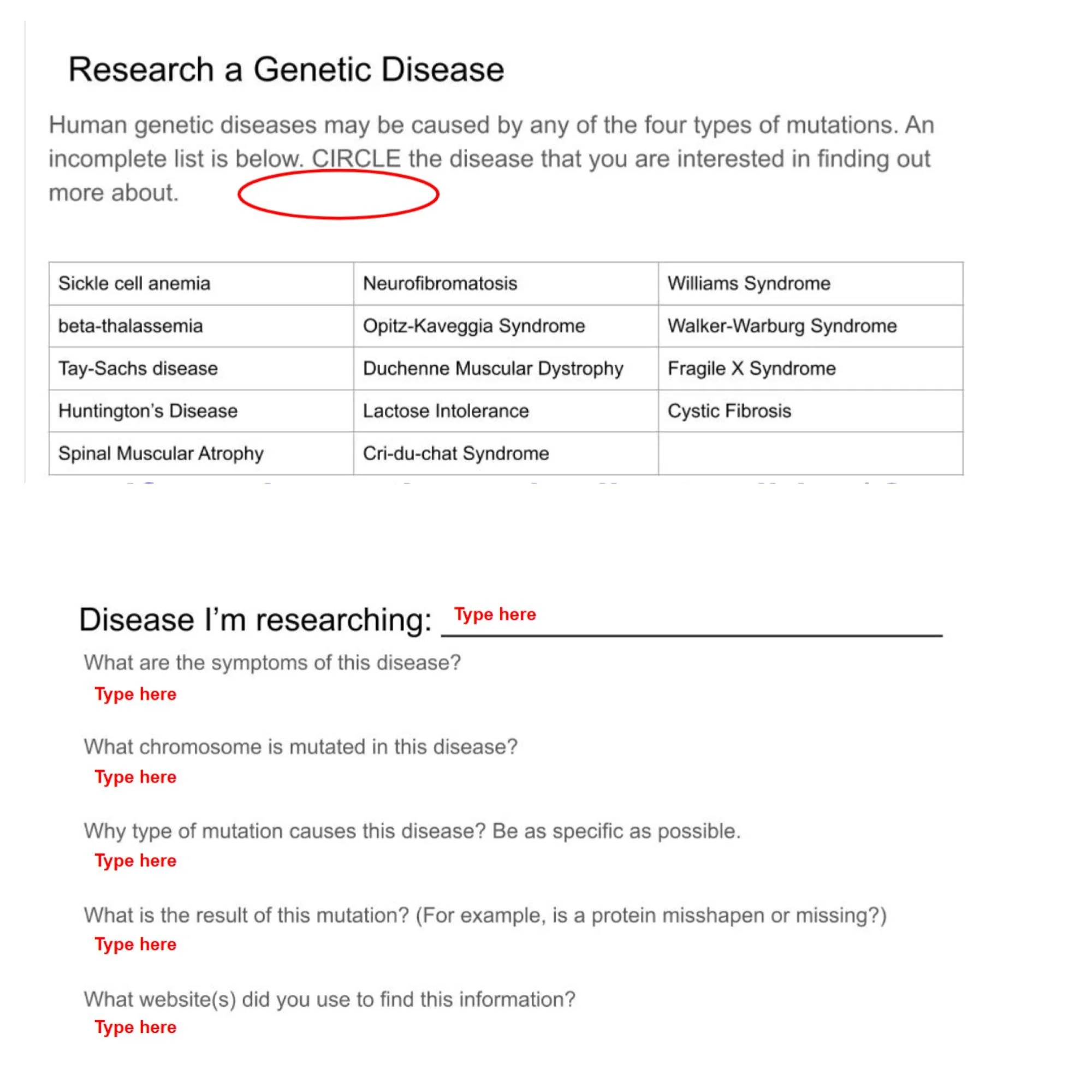



DNA Mutations
Engage Students in a Journey of Genetic Discovery!
Unlocking the Genetic Code: This comprehensive lesson is designed to empower students in unraveling the intricacies of codons, mutations, and mutagens. Through a series of interactive activities, students embark on a captivating exploration of genetic variation.
Student Activities:
Decoding the Genetic Language: Students are introduced to the fundamental concept of codons and delve into understanding their role in genetic information.
Mysteries of Mutations: Through interactive simulations, students unravel the four basic types of mutations - point, frameshift insertion, frameshift deletion, and inversion. They develop the proficiency to identify and differentiate these genetic alterations.
Codon Exploration: Students engage in the task of deciphering DNA strands into codons. They then repeat the process, discerning the specific DNA mutation that has transpired between the initial and subsequent iterations.
Venturing into Mutagens: Students are introduced to mutagens, agents that induce genetic mutations. They follow the genetic transformations in a human cell, belonging to the intriguing character 'Bob,' who grapples with a series of health-related decisions.
Unraveling Genetic Disorders: Students embark on a research mission, delving into real-world human genetic diseases. They report back on the predominant type of mutation responsible for the onset of these conditions.
Why Choose this Lesson?
Comprehensive Understanding: Provides a holistic exploration of codons, mutations, and mutagens, ensuring students grasp the nuances of genetic variation.
Engaging Simulations: Interactive activities immerse students in hands-on genetic analysis, enhancing comprehension and retention.
Critical Thinking: Encourages analytical thinking and evaluation of genetic alterations, fostering a deeper understanding of molecular biology.
Empowering Scientific Inquiry: Sparks curiosity and nurtures independent inquiry skills, essential for any budding geneticist.
Unlock the Secrets of Genetic Variation: Download this captivating lesson now and witness students embark on a journey of genetic discovery!
Grade & Course Recommendation:
Middle School: Grade 8 advanced life science or biotechnology enrichment.
High School: Core Grade 9–10 Biology unit on heredity and gene expression.
Cross-Curricular Connections:
ELA Integration: Students explain mutation effects using cause-and-effect writing.
Health Science Integration: Connects to genetic disorders, cancer, and biotechnology ethics.
Technology Integration: Can include virtual mutation simulations or codon translators.
Daily slide + literacy - based exit ticket included with purchase
Join the Lesson Laboratory and Teach for Tomorrow!
NGSS (Next Generation Science Standards)
HS-LS1-1: Construct an explanation based on evidence for how the structure of DNA determines the structure of proteins, which carry out the essential functions of life through systems of specialized cells. (connection: how mutations in DNA alter protein structure and function)
HS-LS3-1: Ask questions to clarify relationships about the role of DNA and chromosomes in coding the instructions for characteristic traits passed from parents to offspring. (connection: exploring mutations at the genetic level and their inheritance implications)
HS-LS3-2: Make and defend a claim based on evidence that inheritable genetic variations may result from new genetic combinations, errors during replication, and/or mutations caused by environmental factors. (connection: identifying mutation types and their potential effects on traits)
Science & Engineering Practices: Analyzing and interpreting data; Constructing explanations; Engaging in argument from evidence.
Crosscutting Concepts: Cause and effect; Structure and function; Stability and change.
Common Core State Standards (ELA – Literacy in Science & Technical Subjects)
CCSS.ELA-LITERACY.RST.9-10.4 / RST.11-12.4: Determine the meaning of symbols, key terms, and other domain-specific words and phrases as they are used in a specific scientific context. (connection: vocabulary such as “frameshift,” “point mutation,” “codon,” and “inversion”)
CCSS.ELA-LITERACY.WHST.9-12.2: Write informative/explanatory texts, including the narration of scientific procedures or analyses. (connection: explaining how mutations affect genetic information)
CCSS.ELA-LITERACY.RST.9-10.7 / RST.11-12.7: Integrate quantitative or technical information expressed in words with a version of that information expressed visually (e.g., using codon sequences or mutation diagrams).
Engage Students in a Journey of Genetic Discovery!
Unlocking the Genetic Code: This comprehensive lesson is designed to empower students in unraveling the intricacies of codons, mutations, and mutagens. Through a series of interactive activities, students embark on a captivating exploration of genetic variation.
Student Activities:
Decoding the Genetic Language: Students are introduced to the fundamental concept of codons and delve into understanding their role in genetic information.
Mysteries of Mutations: Through interactive simulations, students unravel the four basic types of mutations - point, frameshift insertion, frameshift deletion, and inversion. They develop the proficiency to identify and differentiate these genetic alterations.
Codon Exploration: Students engage in the task of deciphering DNA strands into codons. They then repeat the process, discerning the specific DNA mutation that has transpired between the initial and subsequent iterations.
Venturing into Mutagens: Students are introduced to mutagens, agents that induce genetic mutations. They follow the genetic transformations in a human cell, belonging to the intriguing character 'Bob,' who grapples with a series of health-related decisions.
Unraveling Genetic Disorders: Students embark on a research mission, delving into real-world human genetic diseases. They report back on the predominant type of mutation responsible for the onset of these conditions.
Why Choose this Lesson?
Comprehensive Understanding: Provides a holistic exploration of codons, mutations, and mutagens, ensuring students grasp the nuances of genetic variation.
Engaging Simulations: Interactive activities immerse students in hands-on genetic analysis, enhancing comprehension and retention.
Critical Thinking: Encourages analytical thinking and evaluation of genetic alterations, fostering a deeper understanding of molecular biology.
Empowering Scientific Inquiry: Sparks curiosity and nurtures independent inquiry skills, essential for any budding geneticist.
Unlock the Secrets of Genetic Variation: Download this captivating lesson now and witness students embark on a journey of genetic discovery!
Grade & Course Recommendation:
Middle School: Grade 8 advanced life science or biotechnology enrichment.
High School: Core Grade 9–10 Biology unit on heredity and gene expression.
Cross-Curricular Connections:
ELA Integration: Students explain mutation effects using cause-and-effect writing.
Health Science Integration: Connects to genetic disorders, cancer, and biotechnology ethics.
Technology Integration: Can include virtual mutation simulations or codon translators.
Daily slide + literacy - based exit ticket included with purchase
Join the Lesson Laboratory and Teach for Tomorrow!
NGSS (Next Generation Science Standards)
HS-LS1-1: Construct an explanation based on evidence for how the structure of DNA determines the structure of proteins, which carry out the essential functions of life through systems of specialized cells. (connection: how mutations in DNA alter protein structure and function)
HS-LS3-1: Ask questions to clarify relationships about the role of DNA and chromosomes in coding the instructions for characteristic traits passed from parents to offspring. (connection: exploring mutations at the genetic level and their inheritance implications)
HS-LS3-2: Make and defend a claim based on evidence that inheritable genetic variations may result from new genetic combinations, errors during replication, and/or mutations caused by environmental factors. (connection: identifying mutation types and their potential effects on traits)
Science & Engineering Practices: Analyzing and interpreting data; Constructing explanations; Engaging in argument from evidence.
Crosscutting Concepts: Cause and effect; Structure and function; Stability and change.
Common Core State Standards (ELA – Literacy in Science & Technical Subjects)
CCSS.ELA-LITERACY.RST.9-10.4 / RST.11-12.4: Determine the meaning of symbols, key terms, and other domain-specific words and phrases as they are used in a specific scientific context. (connection: vocabulary such as “frameshift,” “point mutation,” “codon,” and “inversion”)
CCSS.ELA-LITERACY.WHST.9-12.2: Write informative/explanatory texts, including the narration of scientific procedures or analyses. (connection: explaining how mutations affect genetic information)
CCSS.ELA-LITERACY.RST.9-10.7 / RST.11-12.7: Integrate quantitative or technical information expressed in words with a version of that information expressed visually (e.g., using codon sequences or mutation diagrams).